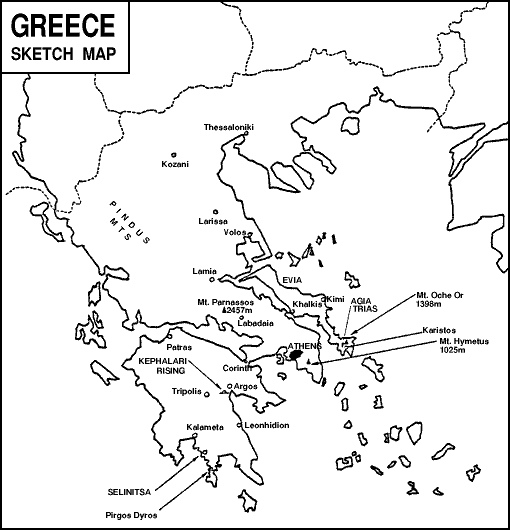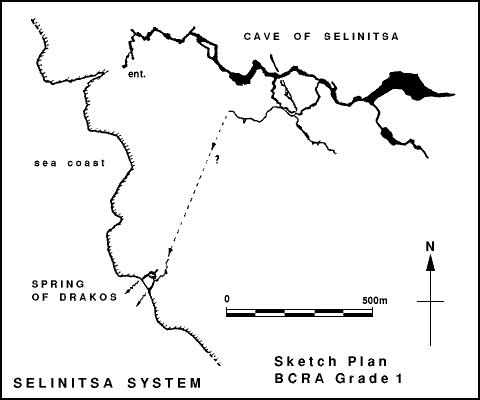
Julian Griffiths
Compared with last year's reconnaissance trip [1] this year's expedition was a much larger affair. Seven cavers including five divers made the long drive down through Europe. We were lucky to have the use of a V8 Land Rover which could cruise effortlessly at 80mph on the autobahns and which raised a few foreign eyebrows when it really cut loose. As a result it took us only two days to get to Greece.
The objectives of the expedition were threefold. We wanted to return to Agia Trias on the southern tip of Evia. Last year exploration had halted at a waterfall after a 30m sump had been passed. Secondly we wanted to continue our exploration of the flooded levels of the Cave of Selinitsa, an old phreatic system in the Mani. Finally a visit was planned to the rising at Kephalari on the plain of Argos, an immense resurgence for sinks north east of Tripolis 20 to 30km away.
As last year though we also wanted to keep our eyes open while travelling in Greece, on the look out for other promising sites and areas.

This cave is situated in the Oche Or, a 1400m limestone peak behind the port of Karistos. It is a resurgence, reputedly linked with pots up to 6km away. In summer the stream in the cave is percolation fed which gives the water a brilliant clarity.
The first ½km to the sump is developed almost entirely along the strike. Past the sump the cave continues along the strike until it breaks into a large waterfall chamber. Last year this waterfall had been climbed to 10m. Although it wasn't apparent to us at the time this was where the cave turned round to head up dip. As a result there was much more climbing than we had anticipated. The first day some fine climbing by John Cordingley gained a tube 25m up which led back into the streamway. An intimidating passage, the Turbine Tube, continued upwards. Downwards the torrent swept over the waterfall. After 20m the roof lifted to form a more normal stream passage. More climbs up lay ahead though; these were done the following day by Geoff Crossley who got up two 8m pitches before the streamway finally headed back along the strike and levelled out. At this point the lower levels of the streamway were very immature and prone to sump, so they were abandoned in favour of the older and more commodious higher levels. These eventually regained the streamway shortly before the upstream sump. All we could do was look at it longingly, we'd left the compressor in Athens and to get a diver to it would have required more tackle on the climbs than the 20m piece of travelling bootlace we were using. The sump has the feel of one that will go easily and there is no doubt much more fine streamway waiting to be explored on the far side. Our disappointment at not being equipped to have a crack at the sump was shortlived though when Jim Abbot and Geoff Crossley walked into an old phreatic passage (via a 20m climb) that contained some of the finest formations any of us had seen. This choked at both ends but clearly represents a much older stage of development than the strike orientated streamway and its higher levels.
By anyone's standards Agia Trias is a very sporting stream cave and is unique in Greece for this reason. It offers considerable potential for further extensions.
This was the scene of much diving activity during the expedition. Both upstream and downstream continuations from the sump pool were explored and by the end of our stay on the Mani the length of submerged passage had been extended to 800m.
The upstream passage pushed last year didn't in fact go very much further. After only 57m it ended in a calcite choke 270m from base. This area was fairly complex and Rob Shackleton entered one passage that rose to a stal grill through which could be seen a flooded chamber. It is possible that a dry continuation of the phreatic passages may be found here.
Fortunately an alternative route was located by a German diver Franzjorg Kneg who was in the Mani at the same time as we were. This led off 70m into the upstream sump and Franzjorg extended this to 120m from base. Rob Shackleton took over exploration and pushed the sump for another 160m, This section included a chamber with an impressive slope of 2 - 3m high stalagmites. The way on at the end was large and open.
This branch of the upstream sump has turned to head up the coast. The source of the water it contains is not known. It may either come from a sink further along the coast or it may be percolation water from the mountains. There is clearly a lot more passage to find here.
Most of the exploration of the downstream sump towards its sea resurgence, the Spring of Dracos was done by Jim Abbott. A large meandering passage being followed for 230m to a depth of -22m. The upstream end of Spring of Dracos (see below) is probably over 600m from this point which would give a through dive of about 1km. It is a difficult site though as the flow of water in the sump is considerable and finning against it is hard work.

The sea resurgence for water seen in the Cave of Selinitsa. About 60m of underwater passage had been explored in 1981, but the main way on hadn't been found.
The continuation was obvious providing the alternative entrance was used. It started large but soon developed into a narrow, tall twisting rift which ended at the head of an underwater pot. This descended 20m to -28m and then a duck under a low arch emerged in a 6 x 6m passage, evidently the main route on towards the Cave of Selinitsa. Exploration halted 160m from base at -15m.
Two other caves were visited in this region, one north of Agio Nikolau, the village close to the Cave of Selinitsa, and one to the south. Both were phreatic remnants of impressive dimensions. A large taste of the potential of the area.
On the way back up Greece the gorge near Lamia noted last year was visited. A very enjoyable two hour walk punctuated by glimpses of wild cats and freshwater crabs ended at a very narrow ravine. Climbing up through this was almost like caving, but at the top the limestone ended and a block of conglomerate began. There appears to be limestone further up and it may be that the water resurges from this.
Further north between Larissa and Katerini the main coast road cuts through a very prominent limestone gorge, the Valley Tembi. Several springs are signposted along this valley so we went to have a look at them. From the south the first was the Spring of Venus, this drained the south side of the valley and was small and impenetrable. The next was Agia Paraskevis draining the north side. This was a large resurgence of very clear water unfortunately capped by a church. A small opening behind the resurgence led down to a small sump which could give access to the main passage but permission would presumably have to be sought from the church authorities. At its entrance one could pick up a small devotional tallow candle to explore the short length of passage.
Further up is the Spring of Daphne, a reasonably sized resurgence draining the south side and capped. North of the valley were two small and impenetrable resurgences - the Spring of Diane and the Spring of the Muses.
There is evidently still a lot of interesting cave to be explored in Greece. The more we did this summer the more possibilities seemed to open up. So far we have restricted our explorations to easily accessible sites and have not yet attempted to look in the mountains, nor have we asked what has been found up there. It may be that because of the very arid conditions prevailing in the hills that high level entrances are rare. However summer is not really the time to go prospecting, the best time would be October, the days have cooled and there is no snow covering. For those who return there should be some spectacular discoveries.
References:
[1]. Cambridge Underground 1982
pp 25-37
[2]. Northern
Pennine Club Journal 1982 pp 69-70